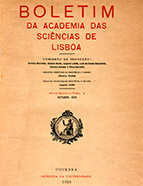

................................
However , although we can find a three-page summary of a presentation by Vitorino Nemésio on “Our spiritual witnesses of the world in crisis” (January-February 1961, pp. 40-42), commemorations dedicated to the fourth centenary of the Colóquios dos Simples [Colloquies on the Simples] of Garcia da Orta (March 1961, pp. 62-67), or even nearly forty pages commemorating the centenary of Eça de Queiroz's birth in 1945 (September-November, pp. 261-300), the transcribed reflections do not seem particularly innovative or representative of what is now considered the most decisive and striking about these authors and themes. This does not mean that only superficial or meaningless words were spoken. But who today quotes the second series of the Boletim as a defining work of its time? Long gone are the days of the Memórias de Literatura … [Memoirs of Literature] or the Memórias Económicas … [Economic Memoirs]— or even the various series of História e Memórias … [History and Memoirs] from the 1820s to 1850s, which contained monographic articles by prominent authors and scholars, historians who wrote from scratch (such as Daniel Estudante Protásio , Estimular o conhecimento histórico? [Stimulating historical knowledge?]). It is possible that this was the function of the Memórias da Academia das Ciências [Memoirs of the Academy of Sciences], which began to be published for the literature and science communities in 1935 and 1936. In the second series of the Boletim , there are transcriptions— often abbreviated— of individual lectures, sometimes randomly themed or collective, dedicated to a specific event. Even an author of Jacinto do Prado Coelho’s calibre contributed in 1962 with a text on “The Presence of France in Portuguese Literature of the 18th and 19th Centuries” (March-April, pp. 123-149). That same year, more than thirty pages were devoted to eulogising Gago Coutinho (January-February, pp. 66-101). However, it is the opinions on the admission of new members, and above all, the impressive list of figures from national culture and historiography, that draw the most attention: Avelino Teixeira da Mota (January-February 1959, pp. 92-94); the aforementioned Prado Coelho, Lindley Cintra, Guilherme Braga da Cruz, and Torquato de Sousa Soares (March-April and October-December 1962, pp. 114-122 and 317-320); or Armando Cortesão and João Ameal (May-July 1964, pp. 303-306 and 345-346). This data will one day be pivotal for the prosopographical study of the Academy’s members from the 1930s to the late 1970s, not least because each issue of the journal in January typically reproduces the governing bodies and includes summaries of the general assemblies and ordinary class sessions (science and literature). It also holds value for the disciplinary study of certain fields. Teixeira da Mota, for instance, frequently contributed substantial articles, such as Novos elementos sobre a cartografia de Portugal no século XVIII [New Elements on the Cartography of Portugal in the 18th Century] (March-April 1962, pp.
This work is financed by national funds through FCT - Foundation for Science and Technology, I.P, in the scope of the projects UIDB/04311/2020 and UIDP/04311/2020.
